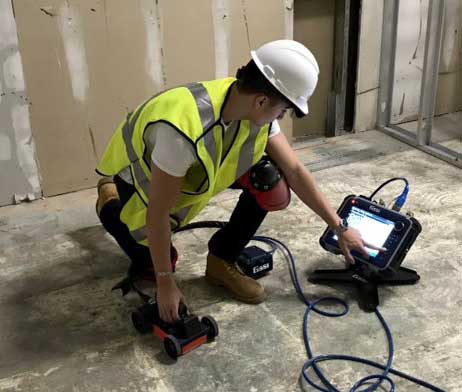Comprehensive Overview to Concrete Scanning Technologies
Comprehensive Overview to Concrete Scanning Technologies
Blog Article
Past the Surface: Leveraging Advanced Concrete Scanning Techniques for Unmatched Precision and Understanding
In the world of construction and facilities maintenance, the quest for accuracy and thoroughness is never-ending. Advanced concrete scanning strategies have actually become essential tools in this pursuit, providing a look below the surface area to introduce a globe of crucial understandings. By harnessing cutting-edge technologies, professionals can uncover abnormalities, evaluate the problem of concrete structures, and make informed choices that shape the program of tasks. The effects of these strategies expand much beyond plain surface-level evaluations, guaranteeing a deepness of precision and understanding that is unmatched.
Significance of Advanced Concrete Scanning
The importance of utilizing advanced concrete scanning methods lies in the unmatched accuracy they supply for discovering sub-surface abnormalities and making certain structural integrity. By employing advanced technologies such as ground-penetrating radar (GPR), electro-magnetic induction, and advanced sonar imaging, construction professionals can dive underneath the surface area of concrete frameworks with a degree of accuracy that far goes beyond standard assessment approaches. Concrete Scanning. These techniques make it possible for the identification of concealed threats like rebar deterioration, gaps, conduits, or post-tension cords that might compromise the security and security of a structure with time
In addition, advanced concrete scanning gives vital understandings right into the total condition of a concrete component without the requirement for invasive steps, decreasing the risk of triggering damages during the assessment procedure. The ability to pinpoint the specific location and deepness of potential concerns allows for targeted fixings and upkeep, ultimately lengthening the lifespan of the framework and enhancing its efficiency. In significance, the importance of advanced concrete scanning can not be overstated in the world of building and framework upkeep, where accuracy and reliability are critical.
Sorts Of Cutting-Edge Technologies

Anomalies and Problem Discovery

In enhancement to GPR, concrete scanning strategies like thermography and impact-echo testing are likewise efficient in detecting flaws and abnormalities. Thermography utilizes infrared technology to recognize variants in surface temperature, showing potential areas of worry such as delamination or dampness ingress. On the various other hand, impact-echo testing entails examining acoustic actions to spot voids, cracks, and various other flaws within the concrete. By leveraging these innovative strategies, experts can proactively resolve architectural problems, making sure the durability and safety and security of concrete structures.
Assessing Concrete Problem
Exactly how can engineers accurately evaluate the problem of concrete structures to ensure their longevity and safety and security? Numerous innovative concrete scanning strategies are employed for this function. Ground-penetrating radar (GPR) is generally used to assess the inner structure of concrete, detecting gaps, fractures, and various other abnormalities that might compromise its strength.
Integrating non-destructive testing techniques with visual evaluations allows for a comprehensive evaluation of concrete problem, making it possible for designers to recognize prospective problems early on and execute timely upkeep or repair services. By leveraging these advanced techniques, designers can make sure the long-lasting resilience and safety of concrete frameworks.
Enhancing Decision-Making Procedures
In the realm of infrastructure management, maximizing decision-making processes is necessary for making sure the effective upkeep and durability of concrete structures. Improved decision-making processes in concrete monitoring include utilizing innovative scanning methods to Extra resources collect in-depth data on the condition of frameworks. By leveraging innovations such as ground-penetrating radar and 3D imaging, stakeholders can make enlightened decisions pertaining to substitute, support, or repair work approaches.
These advanced scanning strategies provide very useful insights right into the internal structure of concrete, recognizing potential problems such as gaps, cracks, or rust that might not be noticeable on the surface area. This level of comprehensive details permits proactive upkeep preparation, minimizing the threat of structural failures and increasing the overall lifespan of concrete frameworks.
In addition, by incorporating digital documentation and analysis tools into the decision-making process, stakeholders can track the advancement of concrete conditions over time, enabling predictive maintenance strategies and optimizing resource allocation. Ultimately, the integration of advanced concrete scanning techniques enhances decision-making procedures by giving unparalleled precision, understanding, and efficiency in framework administration.
Verdict
In verdict, progressed top article concrete scanning methods provide unequaled accuracy and insight in identifying abnormalities, flaws, and examining the condition of concrete structures. By leveraging cutting-edge modern technologies, decision-making processes can be improved, resulting in even more enlightened and reliable remedies for preserving and repairing concrete framework. These methods play a critical role in ensuring the safety and security and long life of concrete structures, making them an important tool in the area of construction and design.
In addition, advanced concrete scanning provides very useful insights right into the general problem of a concrete aspect without the demand for invasive actions, lessening the risk of creating damage throughout the assessment process - Concrete Scanning. An additional ingenious modern technology is 3D X-ray scanning, which offers thorough pictures of the inner structure of concrete, supplying important details without the need for devastating testing. Furthermore, Concrete Cover Meters are used to gauge the density of concrete cover over support bars precisely. Enhanced decision-making procedures in concrete management involve using advanced scanning strategies to gather detailed data on the condition of structures.In verdict, progressed concrete scanning methods supply unequaled accuracy and insight in detecting anomalies, flaws, and examining the problem of concrete structures
Report this page